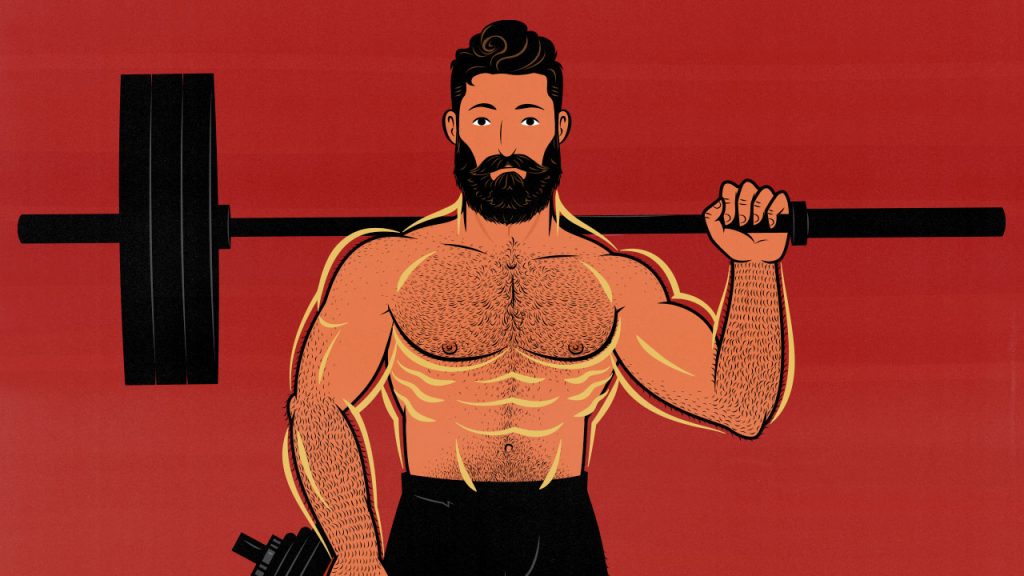
The Best 6-Day Workout Split for Building Muscle
6-day workout splits can be remarkably good for building muscle. With so many training days to play with, you can take several different approaches, ranging from minimalism to total maximalism. You can get great results with 20-minute workouts. You could also lift for an hour every day, building a truly terrifying amount of muscle.
However, when you’re training this often, it’s easy to wear yourself out. You’re stressing your hands, postural muscles, and joints almost every day of the week. You need to be smart about it. Fortunately, there’s a long tradition of training 6 days per week. All the lumps have been hammered flat.
The two most popular 6-day workout splits are the push/pull/legs split and the upper/lower split. Both can be great for building muscle, but one makes for a better default, especially when done right.
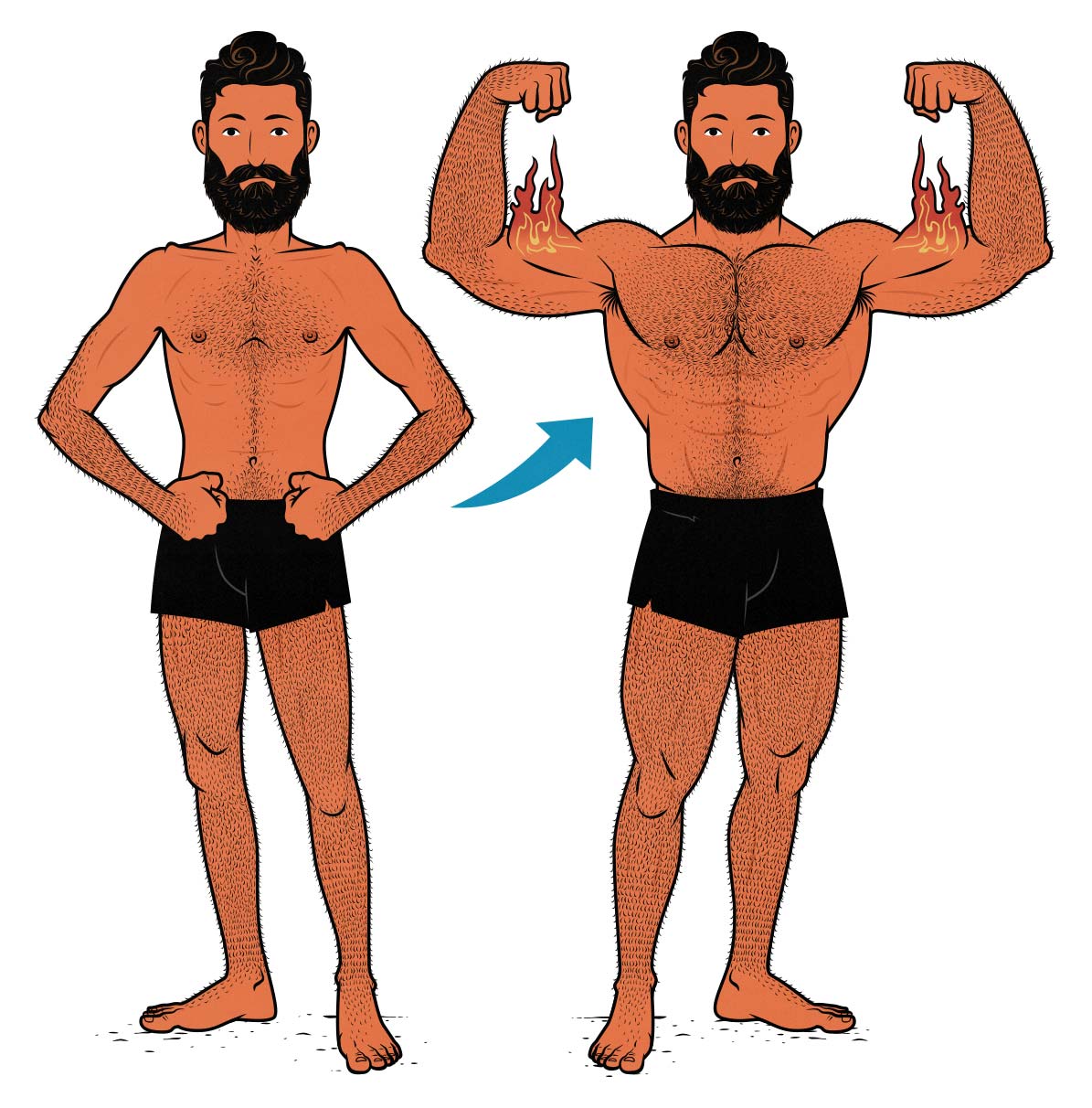
What Are 6-Day Workout Splits?
6-day workout splits are workout routines that have you doing 6 different workouts per week. The most common is the push/pull/legs split, where each day focuses on a different area of the body, like so:
- Monday: Push Day
- Tuesday: Pull Day
- Wednesday: Leg Day
- Thursday: Push Day
- Friday: Pull Day
- Saturday: Leg Day
- Sunday: Rest
The idea is that a vigorous workout can stimulate 2–3 days of growth. If you train a muscle every day, you won’t fully recover, and your performance will suffer. If you wait longer than 3–4 days, you’ll miss out on an opportunity to stimulate a new wave of growth.
You can train your muscles more often if you train them more gently. This is called high-frequency training. You can find 6-day splits that train every muscle every workout. I don’t recommend it. It doesn’t stimulate extra muscle growth, and it’s hard to avoid overuse injuries.
Another popular variation is the 6-day upper/lower split, where you alternate between training your upper and lower body, like so:
- Monday: Upper Body
- Tuesday: Lower Body
- Wednesday: Upper Body
- Thursday: Lower Body
- Friday: Upper Body
- Saturday: Lower Body
- Sunday: Rest
I’m a fan of Upper/Lower Workout Splits, but the 6-day version is a bit much, especially for your back and postural muscles. In our experience, the Push/Pull/Legs Split stimulates just as much muscle growth while doing a better job of managing recovery.
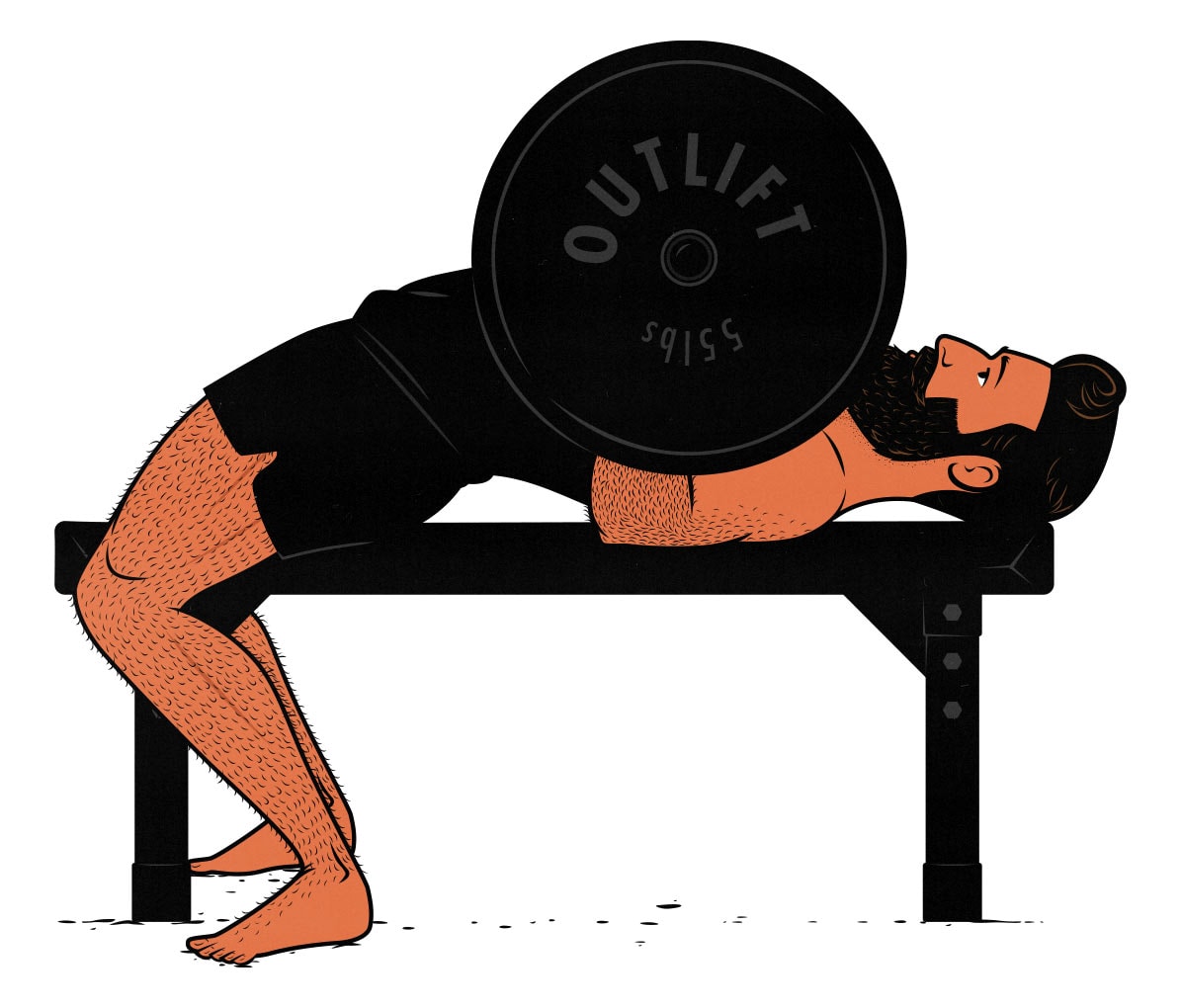
Are 6-Day Workout Splits Effective?
6-day workout splits are fantastic for building muscle. They aren’t necessarily better than 3-day, 4-day, or 5-day routines, though. It all depends on what exercises you choose, how well you train, how much effort you put in, and how you divide up your training volume.
Dividing your training volume into 3 full-body workouts is a great default, especially for beginners. I gained my first 50 pounds that way. But as your lifts grow gradually heavier, those workouts begin to drag, and you may find yourself losing the will to lift. Plus, 3-day routines don’t leave nearly as much room for isolation lifts.
A 4th workout spreads your volume thinner, making each workout a little easier. A 5th day makes those workouts easier still. When you have 6 training days, your work is spread so thin that you can either leave the gym feeling fresh or pile on more sets and exercises. That gives you two options:
- Spread your volume thin: By spreading your volume over 6 training days, you only need 2–3 exercises per workout to stimulate every muscle with great volume and frequency. You can be out of the gym in 20 minutes.
- Stack your volume high: With 6 rigorous workouts per week, you have time to train each muscle as well as it could possibly hope to be trained. You can bulk up aggressively and effectively.
We’ll give you a 6-day split that flirts with both of those approaches. There are 4–5 exercises per workout, which should take you about 45–60 minutes. Then we’ll give you some guidelines for cutting those workouts down or bulking them up.
The main downside of training 6 days per week is it may not leave much energy for cardio. However, if you want to spend a few months focusing purely on muscle growth, 6-day splits can be incredibly powerful.
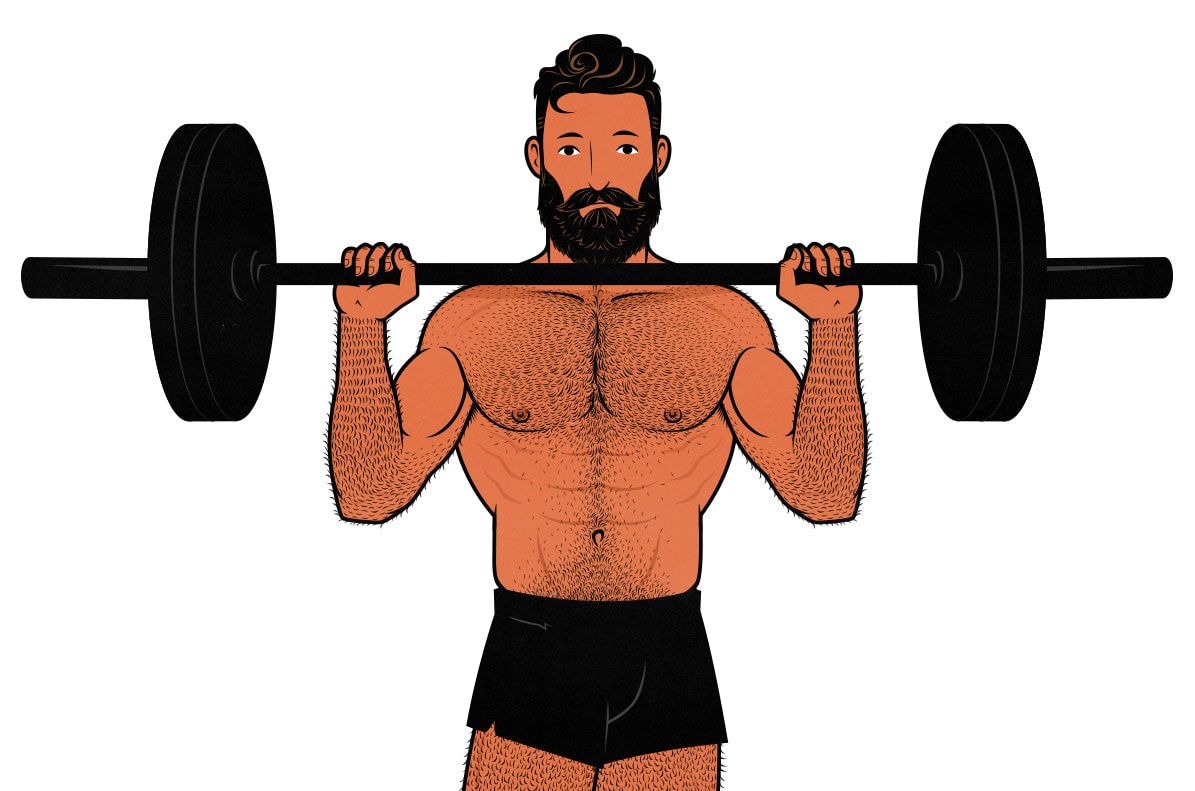
The 6-Day Push/Pull/Legs Split
How the Push/Pull/Legs Split Works
Push/Pull/Legs Splits are common among modern bodybuilders, given that they do a better job of training your legs than traditional bodybuilding routines while still giving plenty of love to your upper body.
We like to build our muscle-building programs on a foundation of progressive overload, ensuring steady size and strength gains, so we’ve built each workout upon a big compound exercise:
- Monday: Push Day (Bench Press)
- Tuesday: Pull Day (Chin-Up)
- Wednesday: Leg Day (Squat)
- Thursday: Push Day (Overhead Press)
- Friday: Pull Day (Pull-Up)
- Saturday: Leg Day (Deadlift)
- Sunday: Rest
For example, on the first Push Day, you begin with the bench press (or another big horizontal press). Then we fill in the rest of the workout with complementary chest, shoulder, and triceps exercises.
On the second Push Day, you start with the overhead press (or another big vertical press). Then we fill in the rest of the workout with complementary shoulder, chest, and triceps exercises.
The bench press and overhead press support one another while emphasizing different pushing muscles. If you get gradually stronger at them in a moderate rep range (6–20 reps), you’ll build a bigger chest and shoulder girdle, guaranteed.
Having a clear focus gives you a clear goal: lift more weight or get more reps on those big compound exercises.
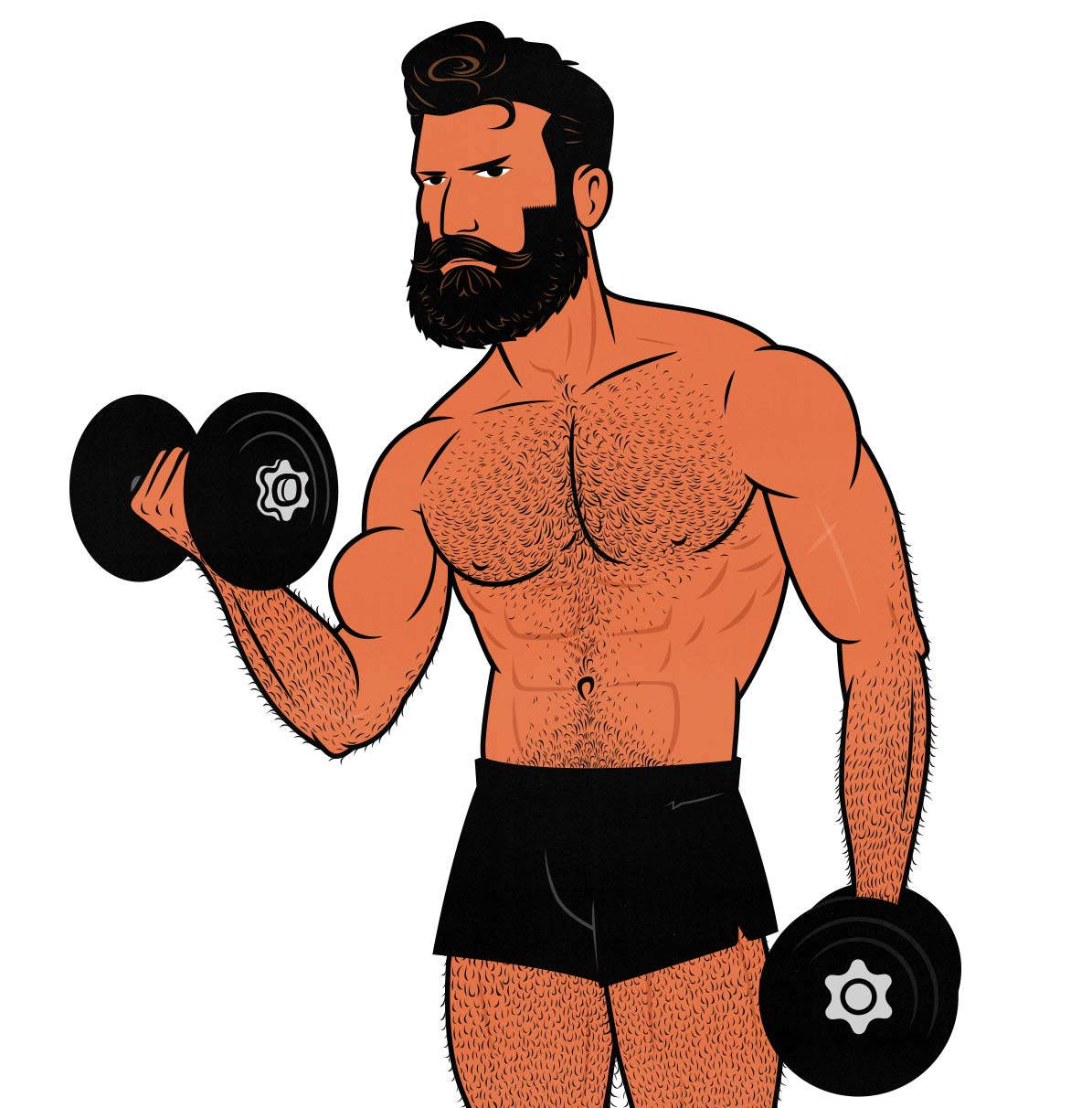
Day 1: Push Day (Bench)
| Exercise | Sets | Reps |
|---|---|---|
| Bench Press | 4–5 sets | 6-12 reps |
| Incline Bench Press | 3–4 sets | 8-12 reps |
| Overhead Dumbbell Press | 3 sets | 10-15 reps |
| Skull Crushers | 3 sets | 10-15 reps |
| Lateral Raises | 3 sets | 12–15 reps |
The first Push Day is built around a horizontal press, such as the bench press. I like to use the dumbbell bench press, barbell bench press, or weighted dip. The chest press machine can work, too.
After the horizontal press, we move to an incline press to give your upper chest and front delts a bit more work. An incline bench press works well here. Landmine presses are another good choice. Some machines are good for this, too.
Skull crushers are an important part of building a bigger bench press. They also train the long heads of your triceps, which haven’t been trained yet. The overhead presses and lateral raises are for your shoulders and upper traps.
Day 2: Pull Day (Chin-Up)
| Exercise | Sets | Reps |
|---|---|---|
| Chin-Up | 4–5 sets | 6–12 reps |
| Seated Cable Row | 4–5 sets | 8-12 reps |
| Lat Pulldown | 4 sets | 10-15 reps |
| Lying Biceps Curl | 3 sets | 10-15 reps |
| Forearm Curl | 3 sets | 12–15 reps |
The first Pull Day is built around the chin-up. I recommend doing them with an underhand, angled, or neutral grip. If you can do more than 12 reps, add some weight.
Seated cable rows come next, done with whatever grip you prefer. If not a seated row, you could do a 1-arm row or use the t-bar row machine. Then come lat pulldowns or dumbbell pullovers. After that, we move to preacher curls and forearm curls for your elbow and wrist flexors (like your biceps and forearms).
If your rear delts don’t get worked very hard by compound pulling movements, you could add some reverse flyes to the end of this workout.
Day 3: Leg Day (Squat)
| Exercise | Sets | Reps |
|---|---|---|
| Squat | 3–4 sets | 6-10 reps |
| Romanian Deadlift | 2–3 sets | 8-12 reps |
| Leg Extension | 3 sets | 10-15 reps |
| Hamstring Curl | 3 sets | 10-15 reps |
| Standing Calf Raise | 3 sets | 12–15 reps |
The first Leg Day is built upon the squat. I like high-bar squats here because they allow for a deep knee bend without overly stressing your spinal erectors, which you’ll need in a moment. You could also do safety squats or use the hack squat machine.
The Romanian deadlift is next. It’s a great assistance exercise for the deadlift, and it’s great for bulking up your hamstrings and back. Then we move to leg extensions and hamstring curls, giving your quads and hamstrings more volume.
Standing calf raises finish off the workout. You can replace them with another exercise if you prefer. Hanging leg raises fit well here.
Day 4: Push Day (Overhead Press)
| Exercise | Sets | Reps |
|---|---|---|
| Overhead Press | 4–5 sets | 6-10 reps |
| Dips | 4–5 sets | AMRAP |
| Chest Fly | 3 sets | 10-15 reps |
| Overhead Extensions | 3 sets | 10-15 reps |
| Lateral Raises | 3 sets | 12–15 reps |
The second Push Day is built around an overhead press variation, such as the standing barbell “military” press. If your back is tired, you could do a dumbbell or machine press. If you want to focus on building a bigger bench press, you could do a close-grip bench press.
After pressing, I like to do dips. They’re easy on your spinal erectors while being hard on your pressing muscles, including your serratus muscles. Overhead pressing works the serratus, too, which is one of the goals of this workout. This will keep your shoulder girdle tough and strong.
After those first two exercises, you can do a giant set of chest flyes, overhead extensions, and lateral raises. If you do them as straight sets, feel free to use short rest times or drop sets.
Day 5: Pull Day (Pull-Up)
| Exercise | Sets | Reps |
|---|---|---|
| Pull-Up | 4–5 sets | AMRAP |
| T-Bar Row | 4–5 sets | 8-12 reps |
| Pullover | 3 sets | 10-15 reps |
| Dumbbell Curl | 3 sets | 10-15 reps |
| Hammer Curl | 3 sets | 10-15 reps |
The second Pull Day is built around the Pull-Up. I like to do those pull-ups with my knees or legs raised, working my abs and shifting a bit more work to my lower lats.
Your back can probably handle quite a lot of volume, so after the pull-ups, I recommend t-bar rows or dumbbell rows followed by some pullovers or lat pulldowns. Make sure you aren’t doing rowing variations that work your spinal erectors too hard. You’ve got deadlifts tomorrow.
Dumbbell curls and hammer curls finish off the workout, bulking up your biceps, brachialis, and brachioradialis.
Day 6: Leg Day (Deadlift)
| Exercise | Sets | Reps |
|---|---|---|
| Deadlift | 3–5 sets | 6-12 reps |
| Leg Press | 3–5 sets | 8-12 reps |
| Back Extensions | 3 sets | 10-15 reps |
| Reverse Crunches | 3 sets | AMRAP |
The second Leg Day is built around the deadlift. I’ve always done sumo, Romanian, or conventional deadlifts here. Trap-bar deadlifts are great, too.
The leg press is a good assistance lift for your squat, and you won’t be limited by your tired spinal erectors. Next are back extensions (or good mornings), where you intentionally train your spinal erectors, bulking them up for your next deadlift day.
Reverse crunches are great for your lower abs. You could swap these out for another exercise if you prefer. The workout ends early because deadlift days ought to be short and sweet, especially when they’re on Saturday.
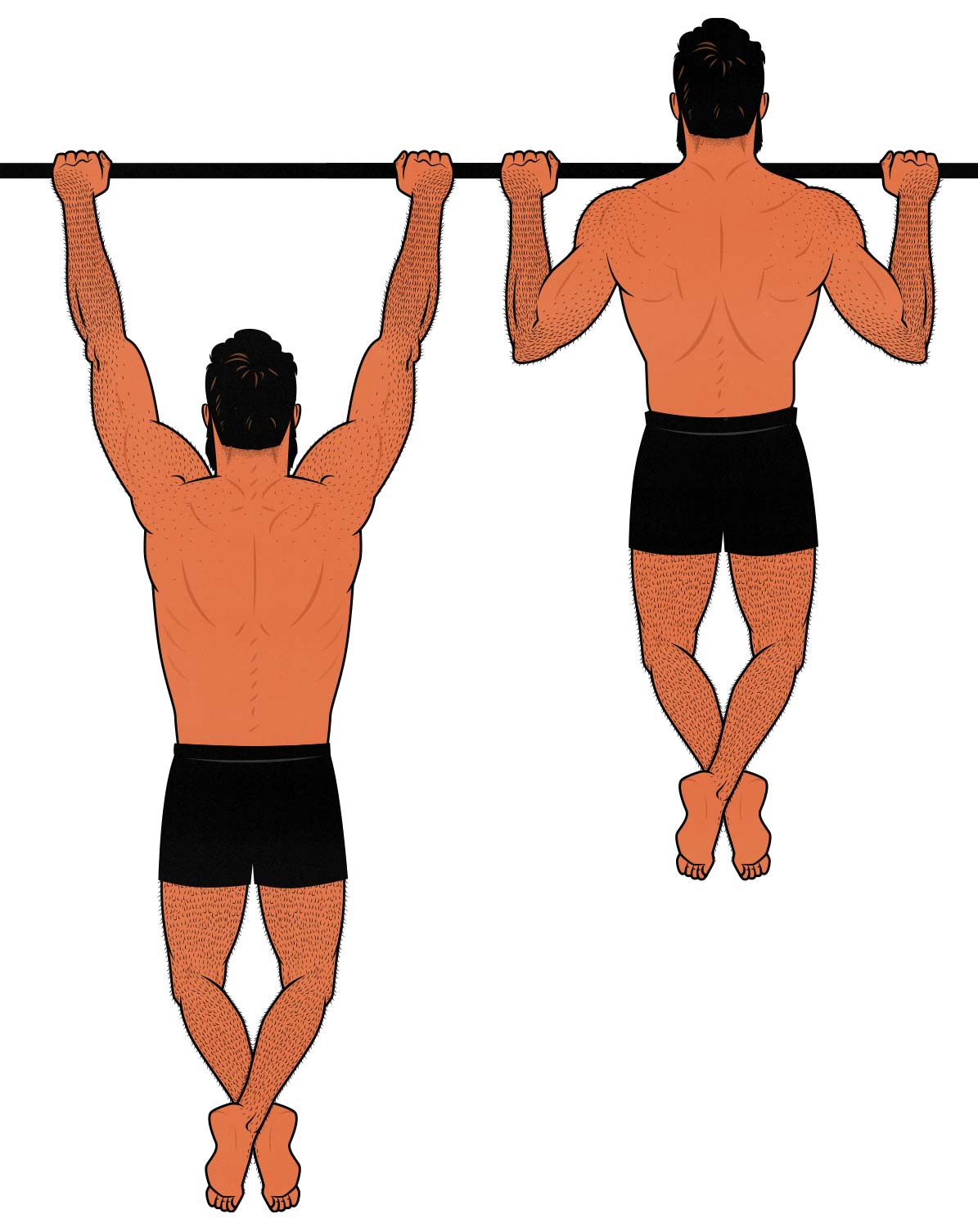
How to Do the Workout Routine
This 6-day workout split hinges on progressive overload. Fight to outlift yourself every workout, especially on the first exercise. Here are some other guidelines:
- Exercise selection: Choose exercises that suit your body and your goals. If you prefer dips to bench presses, choose dips. If you prefer front squats to high-bar squats, choose front squats. If you prefer pulldowns to pull-ups, choose pulldowns.
- Volume: We have 4–5 exercises in each workout by default. In our experience testing these routines on ourselves and clients, this tends to be the best starting point. If you want a minimalist routine, use the first exercise (the main exercise) and pick 1–2 more (of your choice). If you want more than 4–5 exercises, add another.
- Progression: The goal is to gradually get stronger at the first exercise of each workout. If you hit your rep targets last workout, add a little weight. If you’re still trying to add more reps, try to get more total reps than last time. For example, if you got 9, 8, 7, and 6 reps (30 reps) last workout, try to get 31+ reps this workout.
- Rest times: Rest for 3 minutes between sets on the first exercise. After that, rest for 2 minutes between sets. On the final exercise, rest for 1 minute between sets.
- Reps in Reserve: Push yourself hard on the first exercise, leaving 0–1 rep in reserve, ideally without failing your last rep. On the other exercises, leave 0-2 reps in reserve. I like to take the last exercise all the way to failure.
- Muscle-Building Diet: You need enough food to fuel muscle growth. That’s especially important with a routine as rigorous as this one. If you’re skinny-fat or overweight, you can get extra energy from your body fat. If you’re thin or lean, you’ll need to get that energy from your food—you’ll need to gain weight.
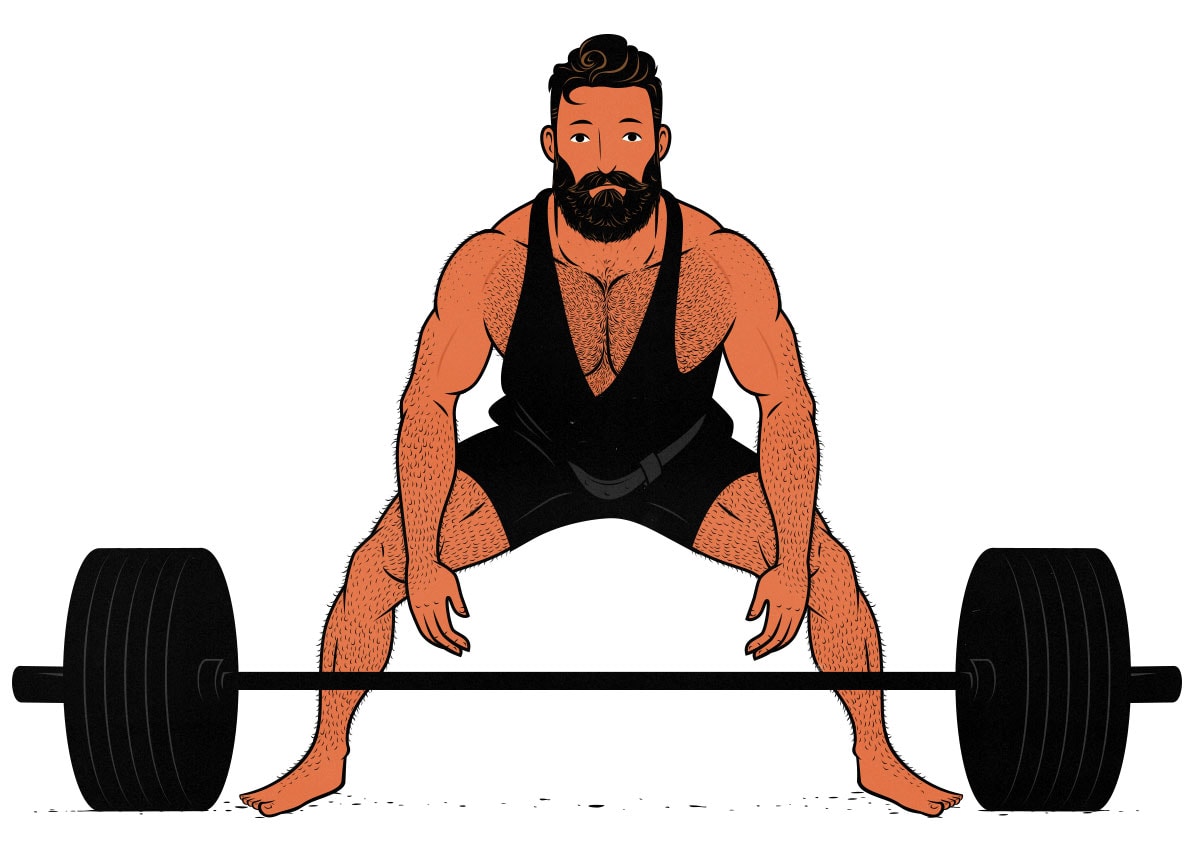
Conclusion
6-day workout splits are fantastic for building muscle. It’s a generous training schedule that can fully maximize your rate of muscle growth, even with relatively short workouts.
Ideally, you’d split up your workouts so that your muscles have 2–3 days of rest before training them again. That’s why 6-day Push/Pull/Legs Splits have stood the test of time. They make for a great default. If you’re confident another approach suits you better, you may be right.
If you have any questions, drop them below. I’ll answer all the comments. If you want the latest research and methods in your inbox, we have a free muscle-building newsletter.



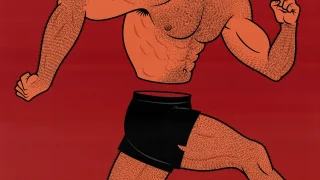
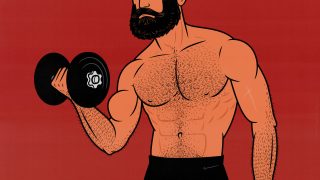
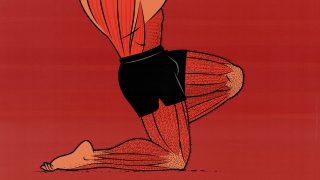

Love this content! Keep them coming please
Thank you, man! Will do.
I’m working on deeper articles about designing each day of these workouts. How to make a Push Day, a Pull Day, a Leg Day, an Arm Day.
I can also add spreadsheet templates to these articles with dropdown menus so you can pick your lifts from a curated selection.
If there’s anything else you want, let me know!
Yes!! That would be great please add that, and I’m assuming this 6 day split can be applied for men and women?
Yep! This routine is great for men and women. Feel free to customise it to suit you better, too.
We’ve got our Bony to Beastly site for men, Bony to Bombshell for women, and Outlift for everyone.
Hi,
My name is Sumanth. I have 2 years of gym experience, but I see only a slight change in my physique. Currently my weight is 89kg at a height of 173cm. I look like I’m obsessed. Is this workout plan for me? Because in the past 2 months on wards I’m doing 9 exercise variations every day with 4 sets of volume each. Can you suggest a good plan?
I hope you can help me with this.
Hey Sumanth, a 6-day routine is a bit intense for a guy with only 2 years of lifting experience, but that isn’t necessarily a bad thing. If you’re enjoying the plan and it’s working for you, stick with it.
This 6-day routine is a pretty good one, if I do say so myself. If you’ve been struggling to get results with other 6-day routines, give this a shot. I think you’ll benefit from it.
If something isn’t working, let me know, and maybe I can help 🙂
What would be good examples of 1-2 exercises to add to each day if I wanted more volume? Just started this program and love the exercises lifted. Just used to more volume.
Woot! Glad you’re liking it.
The simplest way to add volume to a workout routine is to add sets to the exercises that are already there.
My favourite way of adding extra volume is to add extra isolation exercises for the muscles that either aren’t getting stimulated enough and/or the ones you’re especially eager to grow. So maybe on Push Day (Bench Day), that means adding some chest flyes. Maybe on Pull Day (Chin-Up), you add some face pulls and wrist extensions. You could add step-ups to one Leg Day and split squats to the other. Maybe the Push Day (Overhead Press) has some neck exercises, such as neck curls and neck extensions. The Pull Day (Pull-Up) workout could have wrist curls or lat pulldowns.
Hi and thanks for this workout split.
You are dividing the push days into bench day and overhead press day.
During bench day you include shoulder press – 3 sets with up to 15 reps.
During overhead press day the rep range is 4-5 sets with up to 10 reps.
I have only dumbbells and I’m trying to make sense of the weights I have to use. I think I will go for 65-70 % of 1 rep max during bench press day. I will go for 80-85% of 1 rep max during overhead press day.
Do you have any suggestions / reccomendarions?
Thanks in advance
My pleasure, Ziya!
You’ve got the right idea. You’re using the dumbbell shoulder press as a lighter assistance exercise on bench day and as a heavier main exercise on overhead press day.
I don’t use percentages of 1-rep max, but it’s fine to do it that way as long as you get within about 0–2 reps of failure. You’ve chosen sensible ranges. However many reps you wind up getting, try to lift more weight or get more reps in the future.
Dumbbells are fantastic for building muscle, so no worries about that. You’ll have less exercise variety, but dumbbell exercises are pretty easy on your joints and tendons, and you’ll have no trouble hitting every muscle properly.
Good luck!
What are your thoughts on doing each day 6 day PPL, as a circuit, I.e do 1 set of each of 5-6 exercises in a row with little to no rest, then a rest of day 2 mins, then repeat 3-4 times? Pros and cons?
Hey Julian,
I don’t think it’s a terrible idea, but it might be a little less ideal than doing it the normal way.
Supersets, giant sets, and circuits are incredible for gaining muscle and strength, but mainly when you’re alternating between exercises that don’t interfere with one another. Think of squats + chin-ups, or deadlifts + push-ups, or biceps curls + triceps extensions + lateral raises.
PPL routines dedicate entire workouts to similar movements. You’d be combining bench presses with overhead presses and triceps extensions. Those exercises interfere with one another. You won’t be giving your pushing muscles enough time to rest. That won’t ruin your workout, but it isn’t quite ideal, either. At least not in a textbook sense.
The other downside is that you’d need to set up a bunch of equipment all at once. It’d be a lot easier to do straight sets with short rest times. You’d get similar results from that. But I suspect that’s not an issue for you.
If you wanted to train 6 days per week with circuits, you could probably set up some nice supersets/circuits in an Upper/Lower Split. Chin-ups + overhead press, bench press + rows, curls + extensions, and so on. You could take a similar approach with your lower body, pairing leg presses with leg curls, Romanian deadlifts with leg extensions, and so on.
But again, it’s not a terrible idea. If it were me, I would see what I could learn by trying it. I could imagine doing a Push Day where I hop between dips, chest flyes, lateral raises, and overhead extensions. The dips would interfere with everything, but the rest of the exercises wouldn’t, and you’d get a proper rest before going back to the dips (the most important exercise of the day). I could imagine those workouts being short, dense, intense, and effective.
Thanks for all the really great evidence backed articles , I’ve really been enjoying your site since I found it recently. I was wondering what you would consider a good alternative to the leg press on day six; I only have dumbbells available. I believe I’ve found good alternatives for the other exercises at my lifting range (lighter), but have been having trouble finding a good recommendation for the leg press.
Nevermind! I saw your suggestions with the similar routine mentioned in your article “The Best Push/Pull/Legs Routine”.
Ah! Never mind my answer, then.
Thank you so much, Chris!
Any squat variation would do. Maybe one that isn’t too taxing on your lower back. How about split squats?
Just started to train PPL today. And was thinking about where should I put sumo deadlift. I was thinking if I do sumo ddl in Pull day, so I cant squat heavy next day. It was really problem for me but your program really helped me with this. Just put sumo ddl in one Leg day, and squat in another. Simple but brilliant. Also, the set of exercises here is almost the same as what I chose for myself. Thanks for your work brother!
Glad it helped, Artem! Good luck!
I’m confused by the split given by you..i can’t see any workout for the traps…do i need to add any other excercise for that or the excercises given by you are sufficient for my traps?
For the traps, we’ve got overhead press (2x), lateral raises (2x), seated cable rows, Romanian deadlifts, pull-ups, t-bar rows, and deadlifts.
That gives nearly 40 sets for traps, which sounds like 2–4x the ideal training volume, but those exercises won’t be limited by the strength of your traps, so you’d probably do fine. Plus, some of those exercises are for the mid and lower traps, others for the upper traps.
If your traps don’t grow quickly, you can add some shrugs. Most people won’t need them, but it wouldn’t hurt, it might help, and some people need trap isolation exercises to build big traps.